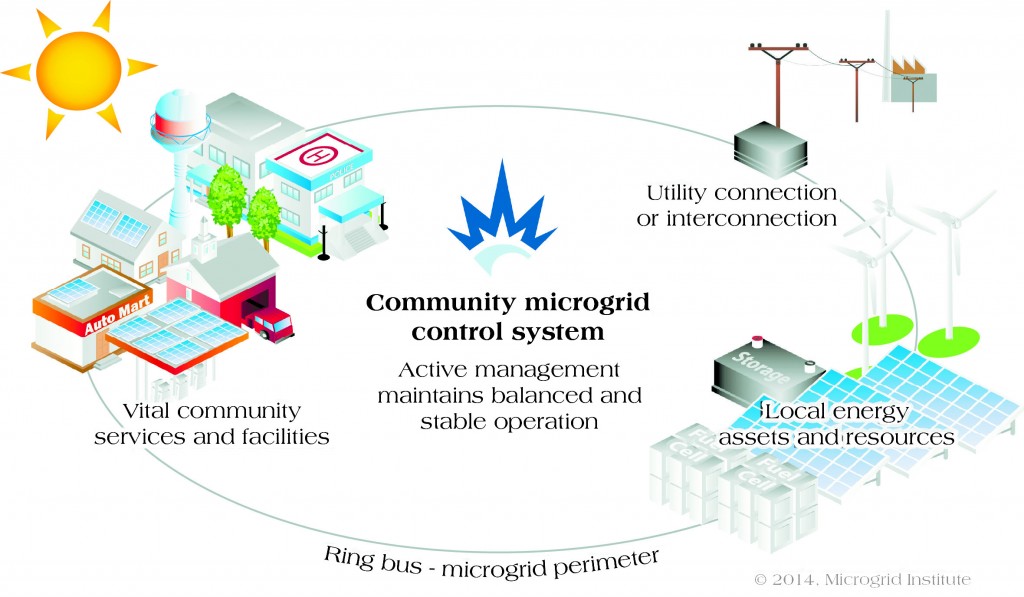By George Harvey

A community microgrid. Courtesy of the Microgrid Institute: www.microgridinstitute.org.
Communities develop where there are resources for their economies. In general, greater resources mean larger or more prosperous communities. Historically, the resources included available water for running mills, forests, mines, roads, and ports or landings, and many others. The early 19th century saw communities develop along canals as they were constructed, and later the same thing happened along railroads, wherever there were stations. The 20th century extended this as access to superhighways, high-voltage power lines, and natural gas pipelines attracted growing businesses. Whether you like these things or not, they drove economic development.
Today, the world is changing in ways many of us could not have imagined only a few years ago. The whole idea of climate change is rather new to nearly all of us. The experiences of tropical storms Irene and Sandy point to more difficult weather ahead. And it is not merely a handful of alarmists who are sounding out on this. Scientists from NASA and NOAA who speak out are unanimous in calling climate change a serious problem. The US military says climate change is a number one security threat for our nation.
There is good news however. Communities can do something about climate change on their own. And interestingly, this can provide not only security for power for all communities of all sizes, but also a set of economic tools for developing a more stable and resilient local economy. The fact that with proper implementation, this can reduce costs for everyone while reducing environmental damage is a pleasant bonus.
One of the most important of those tools is the microgrid, an electrical system that can potentially stand alone and be self-reliant. A microgrid includes generating capacity of some sort, backup power, and the various other equipment needed to power our electric demand. Those of us who live off-grid already have their own microgrids, typically single home structures with solar panels, battery backup, possibly a backup generator, and whatever inverters and controls are necessary to do the job.
Grid-tied microgrids are are common. They are used at hospitals, emergency shelters, police and fire stations, the secure areas of all military installations, and even some apartment buildings. The main difference from an off-grid system is that the grid-tied microgrid has to have a set of switches and other equipment to detach it when the main grid loses power, without which safety issues would arise in general power failures.
A community microgrid is more extensive. Systems large enough to supply entire neighborhoods or towns already exist, but are only commonly found on military bases. Such systems continue to operate when the main grid is without power, and local disruptions usually can be addressed quickly by local crews.
Those community-scale microgrids that are powered by renewable generation sources have the additional feature that they do not need to have fuel delivered, and so can operate indefinitely in the event of a grid failure.
The advantages to a community of having its own microgrid are enormous. The fact that a community can continue operation in the event of large-scale power outage is attractive to anyone who might need to have a very reliable power source. Banks, data centers, brokerages, gas stations, restaurants, hotels, and all sorts of other businesses can benefit from such a system. This is something a community can use to attract investment; it is an economic tool.
Interestingly, even if we could know that the grid would never fail in a particular area, there can be benefits of renewably-powered microgrids. The local generating equipment can supply much or all of the power to the microgrid, even when it is attached to the main grid. This means that equipment installed for power supply resilience also functions to keep the money paid for power within the community. In a community of sufficient size, this will create employment and investment opportunities of its own. This is a second economic tool.
If the microgrid is community-owned, then its profits could be used to lower taxes or pay for services. If the microgrid is investor-owned, then it will pay taxes, and if the investors are local then the profits stay in the community. In either case, the microgrid is a component of another economic tool.
While the problem of global warming is global, some of the best solutions to the problem need to be implemented locally. Interestingly, some of those solutions can also help ensure the long-term prosperity of those communities that implement them.








Leave a Reply